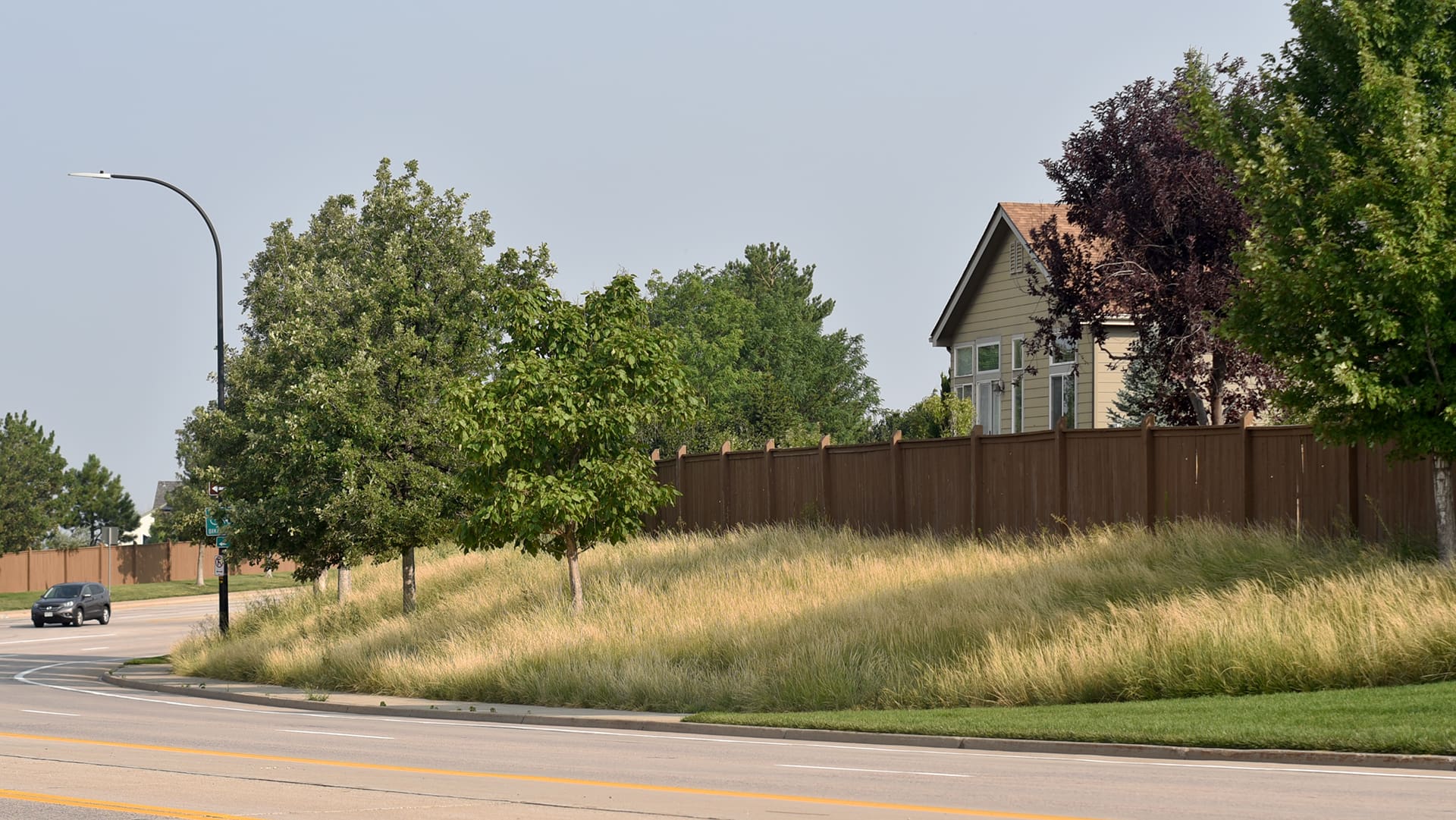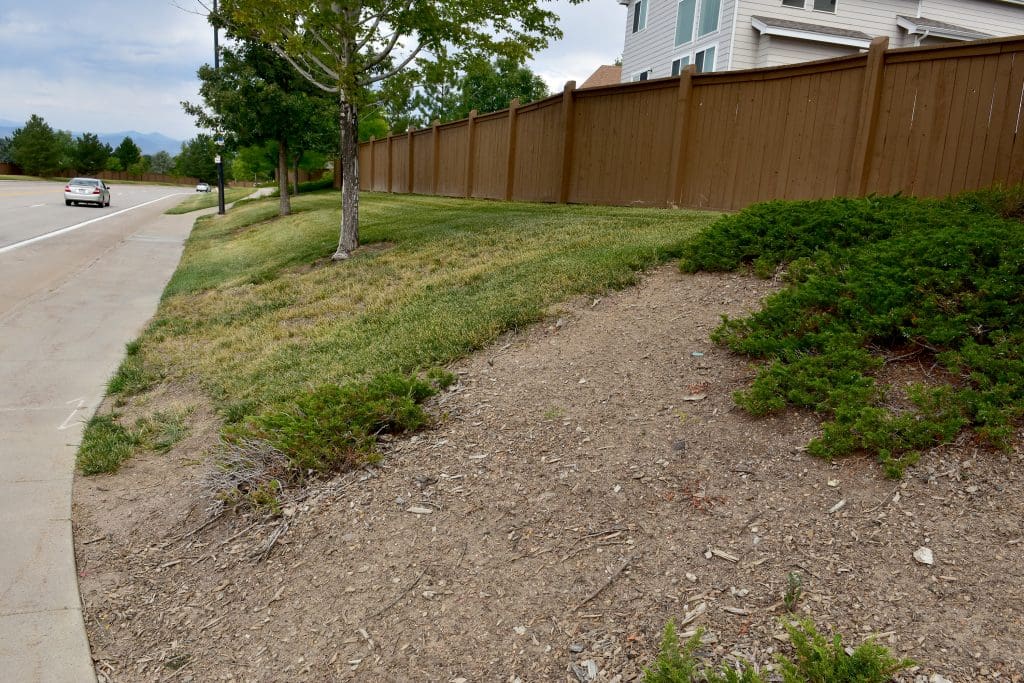
Photo: Highlands Ranch Metro District
When communities are faced with drought and water concerns, it is often lawns that come under fire as a key water waster. The common response is to eliminate turf entirely, ignoring the numerous environmental, economic and socioeconomic benefits turfgrass provides.
However, areas like Highlands Ranch, Colorado, are choosing to replace the grass type used in public spaces that do not receive much foot traffic, rather than removing it. Taking a balanced approach like this rejects the common either/or mindset that you can only have an aesthetically pleasing landscape or save water.
For many years turfgrass was commonly installed as it is relatively inexpensive in terms of landscape plants and provides the instant gratification of turning a brown piece of property into a lush green one. The problem is that many of these swaths in Colorado are covered with bluegrass, a particularly thirsty turfgrass.
“The Metro District is the largest single consumer of water in the community,” says Dirk Ambrose, parks and parkways manager for Highlands Ranch Metro District. “We needed to play our part in setting an example for the community by doing whatever we can to conserve this precious resource.”
Doing Their Research
Driven by the desire to find a less water-thirsty turfgrass like bluegrass, the Highlands Ranch team did extensive research and worked with a landscape consultant to see if a conversion program was viable.
Ambrose says they visited several municipalities that had already had success with their own conversions. He says the City of Colorado Springs shared their victories and challenges, as well as the grass blend they used for conversions.

Photo: Highlands Ranch Metro District
Inspired by Colorado Springs’ work, Highlands Ranch has converted six locations since 2020, totaling around 130,000 square feet of turfgrass.
Ambrose says while their community is more than 40 years old and their residents are accustomed to a manicured landscape, the board understood the importance of conserving water and pursuing different landscape applications.
“They have a responsibility to meet the community’s expectations, and that balance is delicate,” Ambrose says. “They understand the importance of moving forward with turf conversion projects and they are in support of the Parkway Landscape Conversion Program.”
Paige McFarland, water conservation specialist with Centennial Water & Sanitation District, adds that the benefits of native landscapes go beyond water savings. They also support local pollinators, expand biodiversity and reduce maintenance.
“Native landscapes are going to sustain and serve our communities for many decades to come, and they’ll do it using up to 50 percent less water and significantly less maintenance than turf, once established,” McFarland says. “There are benefits to turf, but when you’re looking at the big picture, there’s no contest that installing ColoradoScape is the smart choice for water savings and more.”
Conducting Turf Conversions
Highlands Ranch has 285 acres of parkway landscape and the program is conducted in gradual annual phases. Ambrose says they plan to leave strategic, select areas of bluegrass, but plan to phase out a significant amount of the landscape over the next few years.
“Given the parkway landscape’s topography and proximity to busy roads, the conversion projects are not easy to execute and it will take numerous years to convert even half of our system,” he says.
Locations selected for this conversion are based on several factors, including:
- Landscapes that have historically struggled or consumed excessive amounts of water to stay healthy, often south facing and/or sloped landscape
- Large areas of bluegrass that offer little functionality beyond “background” aesthetics
- Areas that are too narrow to practically irrigate and maintain
- Areas that are conducive for converting in terms of access and irrigation layout

The blend of native grasses used depends on the conversion location. Ambrose says one blend of native-type grasses uses 10 inches of water annually and the other uses about 15 inches of water annually.
“We also have a conversion scenario that consists of replacing narrow strips of high-water use landscape with cobblestone mulch and xeric plants,” Ambrose says. “All three landscape conversion applications consume far less water than our current 27-inch budget that is necessary for watering bluegrass.”
Ambrose notes that it does take one to two years before experiencing reduced water consumption as the native grasses need to get established first.
“Weed management can be demanding for the first few years, but the need gradually reduces as the sites mature. It’s important to understand that, just like with bluegrass, there will always be a need for weed management.
Educating Consumers
While Highlands Ranch is doing their part to cut down on water consumption, one of the conversion program’s goals is to set an example for residents. Often residential properties are guilty of improper irrigation by watering far too often. Ambrose says this typically is due to cultural expectations.
“If you are judging your property’s success by how green your yard is, it’s very easy to default your sprinkler system’s timer to a high setting rather than a lower setting,” he says. “We need to retrain our thinking about what a ‘successful’ landscape looks like.”
Highlands Ranch Metro District has partnered with Centennial Water & Sanitation District, which consistently communicates the need for conservation and provides resources.
McFarland says they publish a Water Wise Guide that is sent to all Highlands Ranch residents each spring, including information on their rebate and incentive programs as well as smart watering practices.


